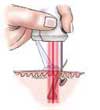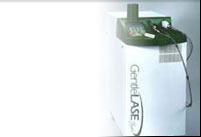Only one of its kind
Candela's unique, Patented Dynamic Cooling Device (DCD) is integrated with all GentleLASE lasers.
 Protection and Efficiency
Protection and Efficiency
DCD reduces pain and maximizes patient protection by delivering a short, targeted burst of non-toxic cryogen onto the top layers of the skin milliseconds before the laser pulse. This evaporative coolant speeds up treatment, without affecting the underlying targeted hair follicles and blood vessels or impeding your visibility.
Greater freedom
DCD reduces the need for cooling gels and expensive anesthesia for most patients. Best of all, it helps decrease treatment times, and allows for quick recovery
How the GentleLASE Plus for Laser Hair Removal Works
To understand how the GentleLASE works, it helps to know a little more about how hair grows and how laser light vaporizes unwanted tissue.
How does hair grow?
Hair forms in a pouch-like structure below the skin called a hair follicle. What we see as hair is actually the hair shaft, which is the keratinized, hardened tissue that grows from this follicle.
Humans have more hair follicles per square inch of skin than most higher primates, including chimpanzees and gorillas. Because most of this hair is fine and pale (called vellus hair), it usually is not visible to the naked eye. Consider this: the forehead has more hair follicles than any other part of the body. The thicker, fully pigmented hair most people consider "real hair" is called terminal hair. This hair is found on scalp, eyebrows, legs, backs, underarms. This is the hair the GentleLASE treats.
Everyone's hair grows differently, depending on age, weight, metabolism, hormones, ethnicity, medications, and other factors. But all hair goes through three distinct growth phases:
 |
Active growth phase (called the anagen phase), which lasts up to several years. At any given time, the majority (85%) of our body hair is in this phase. During anagen, the hair has an abundance of melanin. |
 |
Regressive phase (catagen phase), which lasts about two weeks, during which the hair stops growing but is not yet shed. About 3 - 4% of our body hair is in this phase at any given time. |
 |
Resting phase (telogen phase), which lasts 5 - 6 weeks, at the end of which the hair falls out and a new hair begins to form. Approximately 10-13% of our body hair is in this phase at any one time. |
The GentleLASE most effectively disables hair that is in the active growth (anagen) phase. Because all the hair in a treated area may not be in the anagen phase, more than one laser treatment may be necessary to remove the hair that subsequently enters the growth phase.
How does the GentleLASE work?
A laser produces a beam of highly concentrated light. Different types of lasers produce different colors of light.
The light emitted by the GentleLASE is absorbed by the pigment (melanin) located in hair follicles (melanin pigments give hair its color) and hair shaft. The laser pulses for a fraction of a second, just long enough to vaporize the pigment - disabling several hair follicles at a time to eliminate or significantly impede the hair's regrowth - but not long enough to damage the surrounding skin. The GentleLASE's special contact-cooling hand piece further protects the epidermis (upper layer of skin). This patented method of epidermal preservation allows delivery of more laser energy deeper into the hair follicle.
Additionally, the GentleLASE is able to treat a broader range of skin types than most other hair-removal lasers. It is delicate enough for a woman's fine, sensitive skin and robust enough for a man’s beard, back, or arms.
The GentleLASE effectively removes unwanted body hair. Traditional techniques such as shaving, plucking and waxing, provide only temporary relief and may actually stimulate hair growth. Electrolysis, while effective, often requires years of ongoing and frequently painful treatments. All of these methods commonly result in scarring, allergic reactions, and ingrown hairs. Laser hair removal works by targeting the pigment inside the hair follicle without damaging delicate pores and structures of the skin. Because hair cycles through "growth" and "dormant" phases, and because during the "dormant" phase the follicle has no pigment, at least 2 or 3 treatments will be needed.
GentleLASE Plus can also be used for treating vascular lesions, specifically leg veins from 0.5 to 2.0mm in diameter.
What does the treatment involve?
The patient is asked to wear eye protection.The area to be treated is then shaved. A small hand piece, or "wand" is placed against the skin and a burst of coolant is applied as the laser is activated. The hand piece is repositioned and the laser is activated again. The size or the area treated will determine the number of laser activations, or "pulses", required.
What are the advantages over electrolysis?
With electrolysis, the operator inserts a needle into the hair shaft with the intention of reaching the follicle, then sends a small electrical charge designed to disable the follicle. The operator then removes that particular hair with a tweezer. Hair removal is much faster with a laser as the laser is pulsed about once per second across the surface of the skin. Each "pulse" of laser light disables a large numbers of hair follicles. Electrolysis operators can only treat those hairs that they can see and which they can reach the follicle through the hair shaft. A laser treats any "active" follicle, even if the hair has not yet reached the surface of the skin, or if the hair shaft is not straight.
How many sessions are needed?
The number of sessions will vary for each individual. During the initial visit, the laser light disables those follicles in the "active" phase of the growth cycle. Follicles in the "dormant" phase will not be affected. Since follicles cycle through "active" and "dormant" phases, additional sessions may be desired once the "dormant" follicles become "active". For this reason, we recommend a series of three treatments with a fourth treatment if needed.
Is the laser treatment painful?
While some areas of the body are more sensitive than others, most patients report little or no discomfort. For more sensitive patients, anesthetic creams can be applied prior to the treatment.
Are there any side effects?
Immediately after the treatment the skin will look pink and slightly swollen, similar to a sunburn. This will subside within an hour or two and the skin will return to normal. Occasionally, a patient will have temporary pigment changes, blistering, or scabbing. As with electrolysis, cases of scarring have been reported, but these are extremely rare. A test spot is the best determinant of how each individual's skin will react.




